Spondyloarthritis is a serious disease that can be accompanied by severe pain and movement restriction. Timely diagnosis and treatment will help prevent unwanted consequences.
Contents of
- What is deforming, ankylosing, moderate spondylarthrosis?
- Spondyloarthrosis of the lumbosacral, cervical, thoracic spine: causes
- Spondylarthrosis of the lumbosacral, cervical, thoracic spine: initial signs, symptoms
- Spondylarthrosis of the lumbosacral, cervical, thoracic spine:
- steps How to diagnose spondylarthrosis?
- Which doctor treats spondylarthrosis of arcuate joints?
- Spondylarthrosis - manual therapy
- Spondyloarthrosis: medical treatment
- Spondyloarthrosis: surgical treatment
- Spondyloarthrosis - therapeutic exercises: exercises with photos
- Spondyloarthrosis in pregnancy: consequences
- Will they join the army with spondylarthrosis?
- Does spondiloarthrosis cause sickness, disability?
- Spondyloarthrosis: which sanatoriums are treated?
- Video: Spondyloarthrosis: causes and treatment of spondylarthrosis with NANOPLAST forte
Spondyloarthrosis is a disease of intervertebral joints. There is a destruction of compounds in the vertebral parts, the nerves of the spinal cord are jammed and strong pains appear.
- The consequence of spondylarthrosis is osteochondrosis. Between the vertebrae, space is reduced, mobility is reduced, which leads to subluxation of the processes in the joints.
- Due to incorrect posture, overload of the spine, there is a decrease in the joint gap, sealing of the joint edges, their proliferation. Scions begin to deform and lengthen.
- This disease is degenerative, in which there is cell death and deformation of the spine.
- From this article you will learn what spondyloarthrosis is, its causes, symptoms and what diagnostics there is. Also, you will learn how to treat this disease and how to help yourself to alleviate the condition.
What is deforming, ankylosing, mild spondylarthrosis?
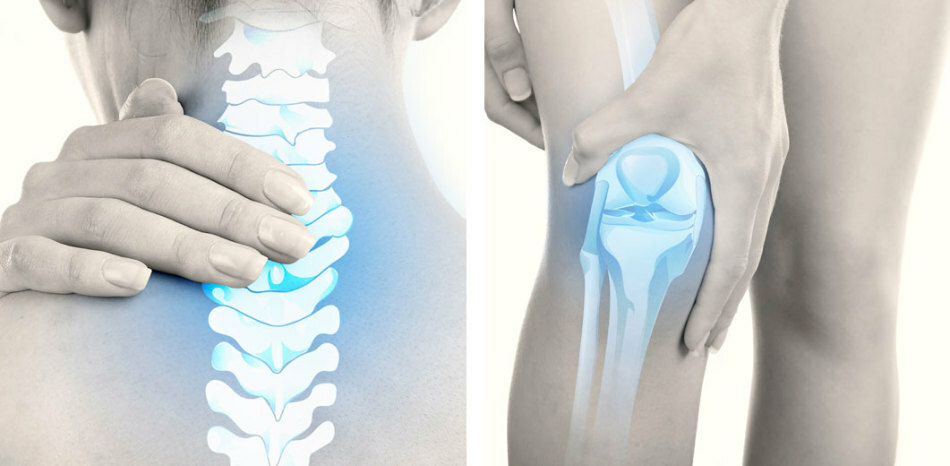 What is deforming, ankylosing, mild spondylarthrosis?
What is deforming, ankylosing, mild spondylarthrosis? Spondylarthrosis is a chronic disease that is not inflammatory. Many diseases and conditions can be a trigger mechanism for disturbing the normal anatomy of cartilage and joints.
Deforming spondylarthrosis is formed under the following conditions:
- spinal injury;
- scoliosis, impaired posture during child growth;
- excessive weight;
- static loads on specific areas of the spine during sedentary work;
- abnormal body mass distribution with flatfoot;
- poor metabolism;
- weak muscular corset in case of hypodynamia;
- osteochondrosis.
Ankylosing spondylarthrosis is a disease that is constantly progressing.
- Inflammation of the intervertebral tissues causes the deposition of calcium salts, which leads to a disruption of the normal function of the spine.
- Violation of the mobility of the vertebrae leads to the fact that it is difficult for a person to turn to the sides, bend or even walk.
- Difficulty breathing, there is a process of violation of cardiovascular function.
- With this type of spondyloarthrosis, the risk of heart attack and stroke is significantly increased.
- Joint growth is an irreversible condition. Therefore, it is important to correctly diagnose and begin treatment at an early stage of the disease.
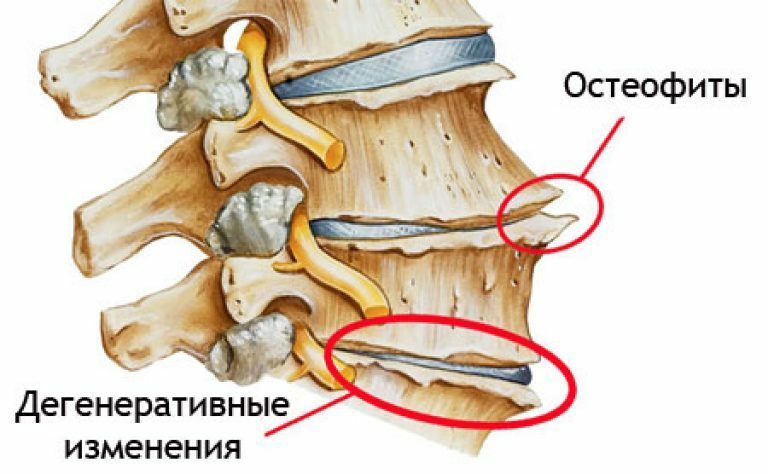 Deforming, ankylosing, mild spondylarthrosis
Deforming, ankylosing, mild spondylarthrosis Moderate spondylarthrosis of is not as acute as ankylosing, but this type of disease is also dangerous and causes pain in the neck or lower back. Usually, this type of disease refers to the first degree, that is, the initial stage of the disease. Read about it below.
To know how to treat a disease, you need to understand the causes of its occurrence. In addition, it is necessary to make a diagnosis to know at what stage the disease is.
Spondylarthrosis of the lumbosacral, cervical, thoracic spine: causes
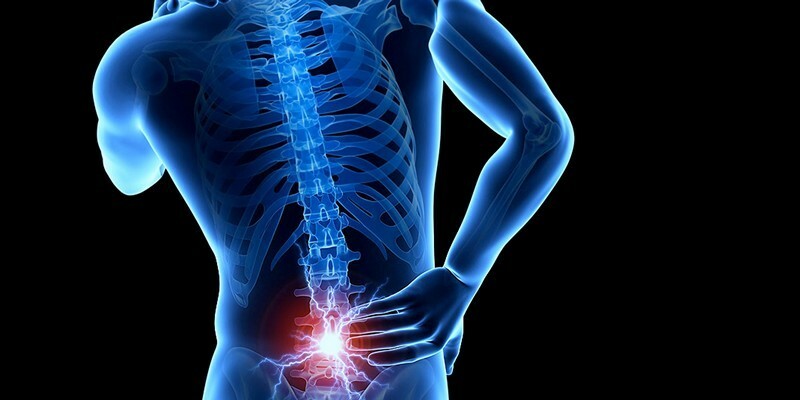 Spondylarthrosis of the lumbosacral, cervical, thoracic spine: causes of
Spondylarthrosis of the lumbosacral, cervical, thoracic spine: causes of Although this disease is widespread among people of different ages, doctors do not have a clear view of the causes,which provoke it. All risk factors can be divided into two groups - external and internal.
To internal risk factors and the causes of spondylarthrosis of the lumbosacral, cervical, thoracic spine should be attributed to the following:
- gender - women are sick more often;
- age - the disease develops mainly in the elderly;
- genetic predisposition ;
- congenital abnormalities vertebral departments.
To external factors should include the following:
- professional activity , which assumes a high load on the spine;
- acute injuries of the vertebrae ;
- excess weight ;
- sedentary lifestyle;
- incorrect posture;
- excessive sports loads.
The presence of one or more factors can trigger the development of the disease.
Spondylarthrosis of the lumbosacral, cervical, thoracic spine: initial signs, symptoms
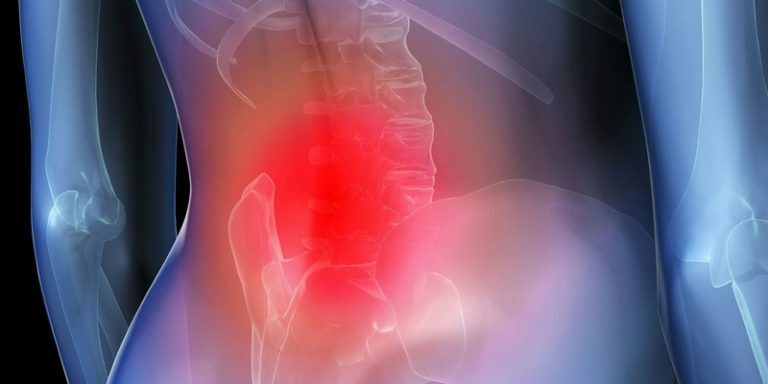 Spondylarthrosis of the lumbosacral, cervical, thoracic spine: initial signs, symptoms
Spondylarthrosis of the lumbosacral, cervical, thoracic spine: initial signs, symptoms Spondylarthritis as an independent disease occurs rarely, and as discussed above, is associated with trauma or withexcessive load on the vertebrae. Therefore, it is important at an early stage to recognize the disease so that it can be successfully cured and not run until irreversible consequences.
Initial signs and symptoms of spondylarthrosis of the lumbosacral, cervical, thoracic spine:
- Stiffness in the back, waist or neck in the morning.
- Meteosensitivity - pains intensify in rainy weather, during frosts and other sudden changes in air temperature.
- The pains are increasing during the physical activity of the during the day, and by evening become unbearable.
- The pain disappears if the horizontal position of the is accepted, and the legs in the knee joints are bent.
- The pain increases if you stay long in one position - sitting or standing.
Symptoms may also appear that indicate the presence of this disease:
- tinnitus;
- pain in the occipital part of the head;
- painful sensations in the arms, shoulder and shoulder area;
- crunch in the neck with its bends and slopes;
- numbness of limbs - arms;
- "crawling cunt" on the hands - an unusual and unpleasant sensation.
If the disease is located in the lumbar spine, the patient has pain in the abdomen, buttocks and inguinal region.
Spondylarthrosis of the lumbosacral, cervical, thoracic spine: stages
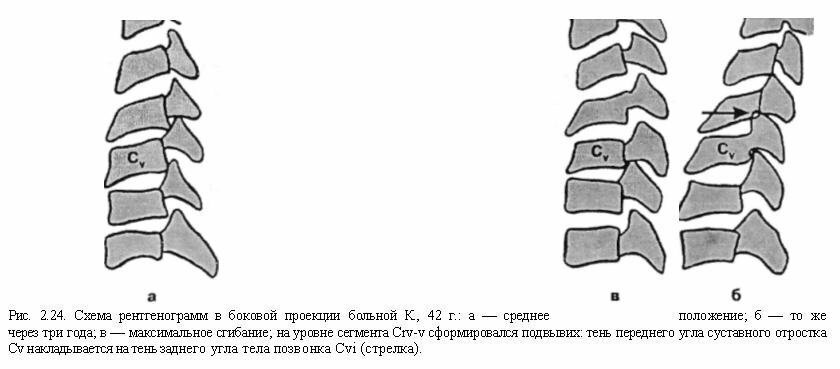 Spondylarthrosis of the lumbosacral, cervical, thoracic spine: stages
Spondylarthrosis of the lumbosacral, cervical, thoracic spine: stages The development of the disease occurs gradually. Therefore, there are 4 stages of spondylarthrosis of the lumbosacral, cervical, thoracic spine:
- The first degree of is the initial stage of the disease. It flows imperceptibly, there are minor pain in the neck or back. At this stage, spondylarthrosis is easy to adjust. But often people do not pay attention to the pains in the back, and postpone the trip to the doctor.
- Second degree. Condition aggravated. There are severe pain when moving from a static position in which a person has been for a long time. Severe pain in the area of localization occurs in the morning, after awakening. But after several warm-up exercises, unpleasant sensations pass - this is a distinctive feature of this stage of the disease.
- The third degree of develops rapidly, if no timely treatment followed the onset of symptoms of the first or second stage. Develop complications that are difficult to combat. Burning pains with a certain localization, atrophy of cartilaginous tissues and as a consequence, the formation of bone outgrowths.
- Fourth degree of - irreversible complications appear. Complete loss of mobility of the intervertebral joints, because of which the compression of nerve endings and vessels occurs. At this stage, disability is inevitable.
If you consult a doctor in a timely manner, carry out a diagnosis, then many unpleasant consequences can be avoided.
How do I diagnose spondylarthrosis?
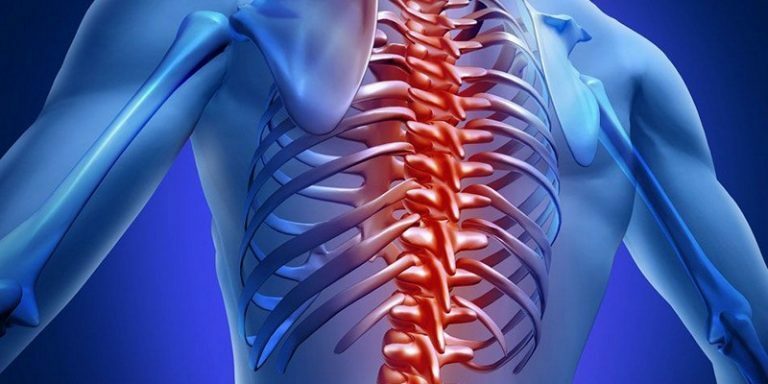 How to make a diagnosis of spondylarthrosis?
How to make a diagnosis of spondylarthrosis? If you have pain in the spine, you should immediately go to the hospital for examination. Do not fret yourself with the hope that everything will pass by itself - so you only exacerbate your condition.
Important: Do not treat yourself, because you do not know what kind of ailment you are worried about, and the correct diagnosis can only be made by a doctor.
How do I diagnose spondylarthrosis?
- When a patient is treated with pain in the spine, the doctor prescribes an X-ray examination.
- Pictures are taken in different projections. According to these pictures, the radiologist, surgeon and even the usual therapist will be able to notice changes in the contours of the joints, if any.
- If there is a suspicion of a soft tissue change, then a scan in the tomograph is assigned.
After the examination, the doctor will be able to prescribe an adequate treatment that will help ease the condition or correct the disease if it is in the first stage.
Which doctor treats spondylarthrosis of arcuate joints?
 Which doctor treats spondylarthrosis of the arcuate joints?
Which doctor treats spondylarthrosis of the arcuate joints? Above was told about deforming, mild and ankylosing spondylarthrosis. But there is another kind of this disease - arcuate.
- During this disease, there are changes in the arcuate joints, in the areas of joints of the spine and ribs.
- Pains appear in the chest area during a bad weather, in the mornings, as well as with violent movements, crunches joints. There is atrophy of the muscles in the lesion.
Which doctor treats spondylarthrosis of the arcuate joints?
- Previously, a neurologist was involved in the treatment of all types of spondyloarthrosis.
- Currently, this is a specialization of a vertebrologist.
- But, if in your locality there is no such doctor, and go to a paid or district clinic far away, then contact a neurologist. He will also prescribe a diagnosis and adequate treatment according to your state of health.
If you do not want to contact a neurologist, then you can come to see a therapist or surgeon. These doctors can also prescribe diagnostics and treatment.
Spondylarthrosis - manual therapy
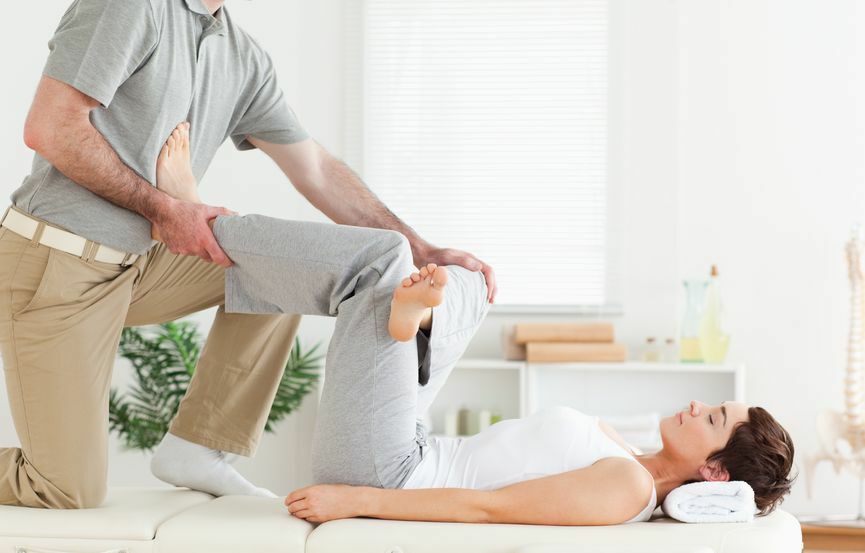 Spondylarthrosis - manual therapy
Spondylarthrosis - manual therapy Spondyloarthrosis causes severe pain in the form of spasms. To remove these unpleasant sensations in the damaged areas will help manual therapy. Massage enhances blood flow and strengthens muscle tissue. The pain syndrome disappears, and the patient's condition improves.
Remember: Manual therapy with spondyloarthrosis is forbidden to use during the course of the acute phase of the disease.
The massage should be performed by a qualified technician, since caution is important in this procedure so as not to injure the deformed vertebrae.
Spondyloarthrosis: drug treatment
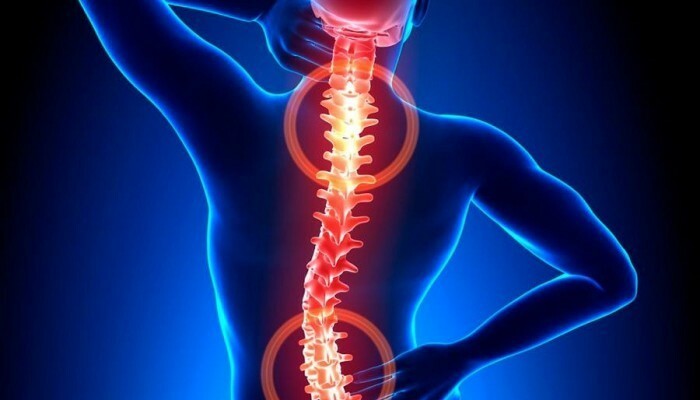 Spondyloarthrosis: medical treatment
Spondyloarthrosis: medical treatment When the diagnosis is made, the doctor prescribes medication. It is carried out by two groups of drugs:
- Pain syndrome helps to stop the analgesics and non-steroidal anti-inflammatory drugs .
- Gradual restoration of cartilaginous tissue helps to produce muscle relaxants, hondoprotectors and B vitamins.
In spondyloarthrosis, this medication is used:
- Diclofenac is a non-steroidal anti-inflammatory drug. Anesthetizes and relieves inflammation.
- Baralgin is an analgesic used for anesthesia. It is not used for violations of the liver and kidneys, as well as during pregnancy.
- Mukosat - has a chondoprotective effect. Helps restore cartilaginous and connective tissue.
- Midokalm is an excellent muscle relaxant. Reduces tension in the muscle tissue.
Important: Only a doctor should prescribe medicines. He will select the right active substance, which will help not only to remove the pain syndrome, but also to repair damaged tissues.
Spondyloarthrosis: surgical treatment
 Spondylarthrosis: surgical treatment
Spondylarthrosis: surgical treatment Surgical treatment for spondylarthrosis is rarely used. This is due to the fact that the pain sensations are perfectly removed by medications in combination with physiotherapy. Also after surgery, there may be some complications:
- spinal cord injury or nerve endings;
- improvements may not occur;
- occurrence of foci of infections;
- pain from bone graft;
- phlebitis of the feet;
- problems with urination;
- absence of bone synthesis.
Indications for the operation of spondylarthrosis are such violations in health:
- Dysfunction of the urinary canal or bladder, changes in the intestine.
- Stenosis of the spinal canal is a disease that affects the vessels and blood circulation negatively, leading to disability.
- Numbness of extremities , other dysfunctions in the field of neurology. Instability of the spinal column .The destruction of the facet joints leads to the development of instability of the spine.
There are several types of surgical intervention that are prescribed depending on the degree of development of the pathology:
- Fasectomy - is performed if there is pressure of the facet joint on the nerves. The joint is removed, thereby eliminating the focus of pressure.
- Foraminotomy - the size of the hole is increased, thereby eliminating the pinched nerve. It is carried out if a part of the disc or spur puts pressure on the nerve end.
- Laminectomy is the partial or complete removal of a plate of one of the vertebrae that protects the vertebral canal or spinal cord. It is performed if the doctor sees the pressure of this plate on the spinal cord.
- Laminotomy - allows you to increase space on the spinal canal. Such surgical intervention is appointed if the plate presses on the nerve endings.
The following actions help to prevent spinal instability:
- Interstitial decompression of - the implant is implanted between the processes. Thanks to this manipulation, the nerves are squeezed, the pain is reduced, the flexibility of the back is maintained, and the range of movements is improved.
- Dynamic stabilization of the spine - implanted structures that help the spine to move in a certain range.
Before the surgery, the patient is assigned a checkup. If the blood counts are normal and there are no contraindications to the operation, then the patient is assigned an operation.
Spondyloarthrosis - therapeutic exercises: exercises with photos
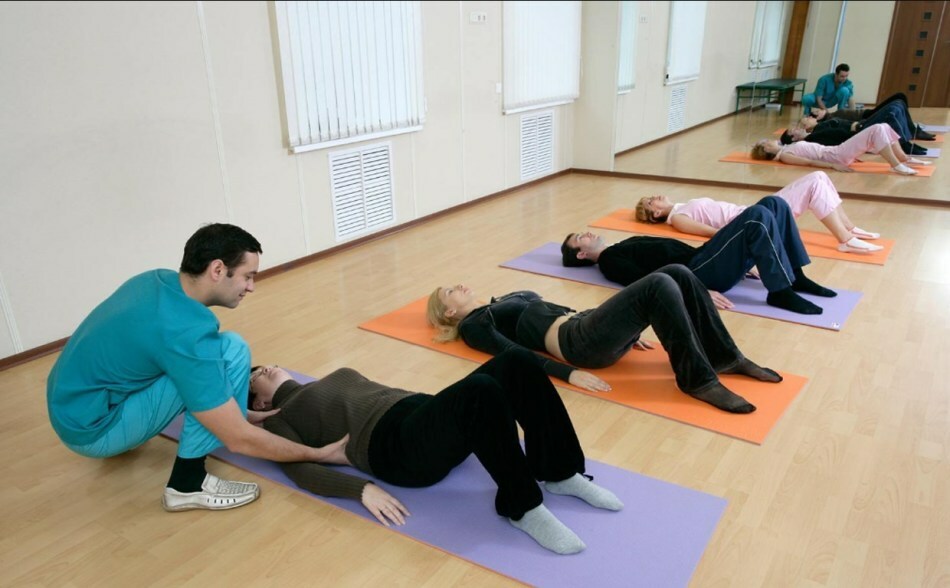 Spondyloarthrosis - therapeutic exercises: exercises with photos
Spondyloarthrosis - therapeutic exercises: exercises with photos Medical gymnastics and orthopedics with spondylarthrosis help to recover faster.
- Physical exercises strengthen the muscular corset, improve blood circulation in the vertebrae and joints.
- It is useful to perform exercises on the Swedish wall for traction: to hang on elongated arms for 30 seconds - 4 repetitions. This exercise is useful in a moderate process.
- Also doctors recommend swimming, which strengthens muscles and relieves spasms.
- Exercises should be selected by the doctor taking into account the patient's condition.
- At the first stage of the development of the disease, only exercise therapy is often enough. At the same time, medication is not prescribed.
Exercise and photo:
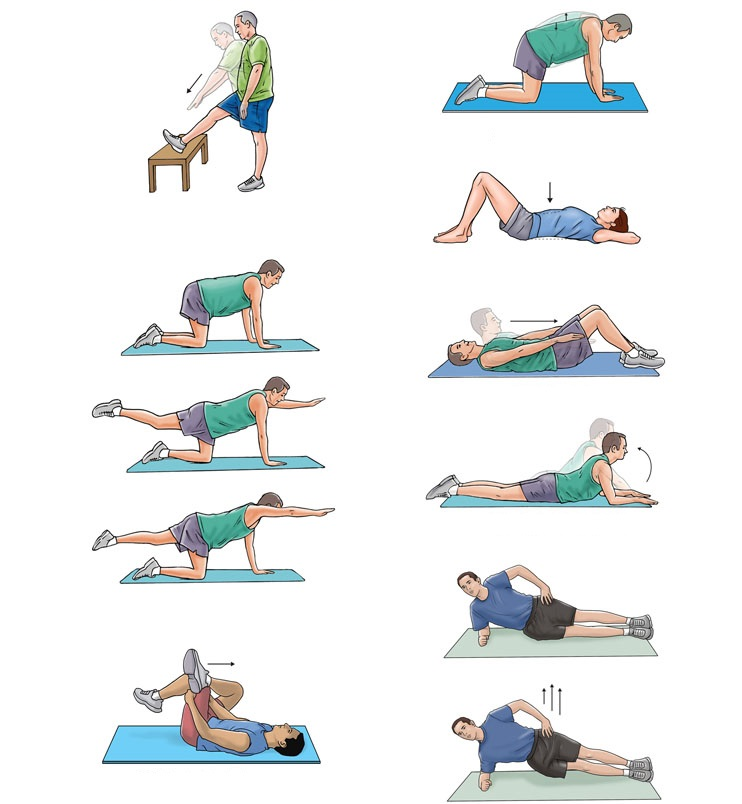 Spondyloarthrosis - therapeutic exercises: exercises
Spondyloarthrosis - therapeutic exercises: exercises - Set a small bench in front of you and put one foot on the heel on it. Lean, trying to get your hands to the toe. The slopes should be neat and soft, bend as low as your back allows. Do the exercise alternately with each leg 10 times.
- Stand on all fours on the rug and start arched back and arching back to its original position - 10 times.
- Lie on your back, your arms are bent under your head, your legs are bent at the knees of .With the help of breaths and breaths, inflate and blow off the stomach - 15 times.
- Again get up on all fours , start alternately raise your right arm and your left leg. Then, on the contrary, the left arm and the right leg. Do this exercise 10 times with each bunch of leg and hand.
- Lie on your back, legs along the trunk of the .Raise your torso, trying to touch your knees with your stomach. If you can not get up completely, do it as much as you allow your muscles to do it. Exercise repeat 10 times.
- Now lie on your stomach, bend your arms in front of you in front of you .Raise and lower the upper part of the body - gently and not to the end, so as not to damage the back. Do 10 approaches.
- Now in the position lying on the floor on the side ( arm bent in the log, legs straight), start lifting and lowering the thigh - 10 times.
- In the supine position, the legs are raised , one leg lies on the knee of the other foot, tighten with the arms of the leg to the body - 10 times.
Important: Exercise gently and slowly. Before starting the session, consult your doctor.
Orthopedics is another way to effectively treat a disease. Wearing special collars, corsets, bandages and belts, can reduce the burden on the spine, reduce pain and eliminate unwanted effects on the circulation.
Spondylarthritis in pregnancy: effects of
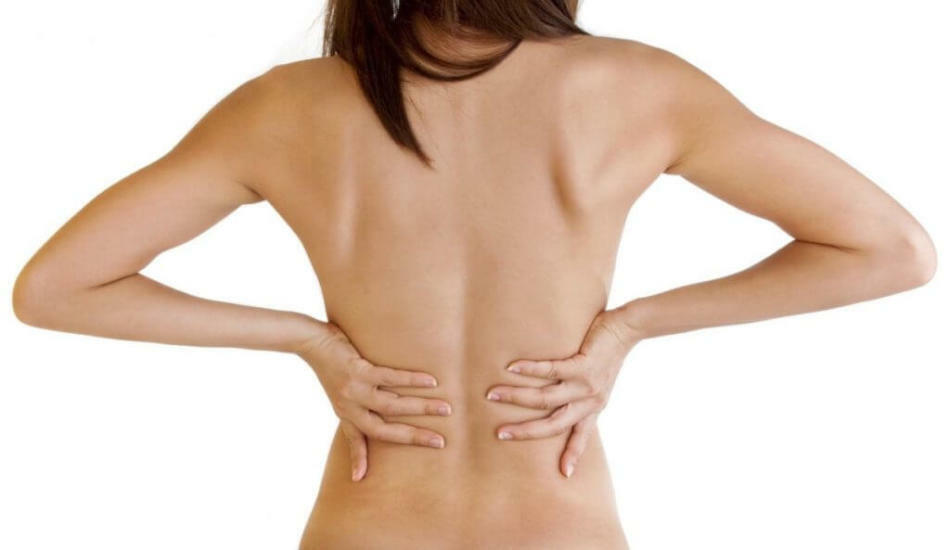 Spondyloarthrosis in pregnancy: effects of
Spondyloarthrosis in pregnancy: effects of When a woman is pregnant, health problems can worsen, which were before the appearance of an interesting situation, but did not make itself felt.
- Consequences of spondylarthrosis in pregnancy are localization pains.
- Often a woman can not even move normally , but this is already in the last weeks of pregnancy, when there is a heavy load on the spine.
- Usually, during pregnancy, doctors try not to prescribe medications so as not to harm the fetus.
- If the pain is severe, then you can use ointments on natural ingredients: bee venom, leech extract.
- But also for the application of such therapy, specialist consultation is needed.
The aggravation of the disease often occurs after the birth, and the woman feels relieved. But you can not delay the trip to the doctor, as the disease can progress.
Will they join the army with spondyloarthrosis?
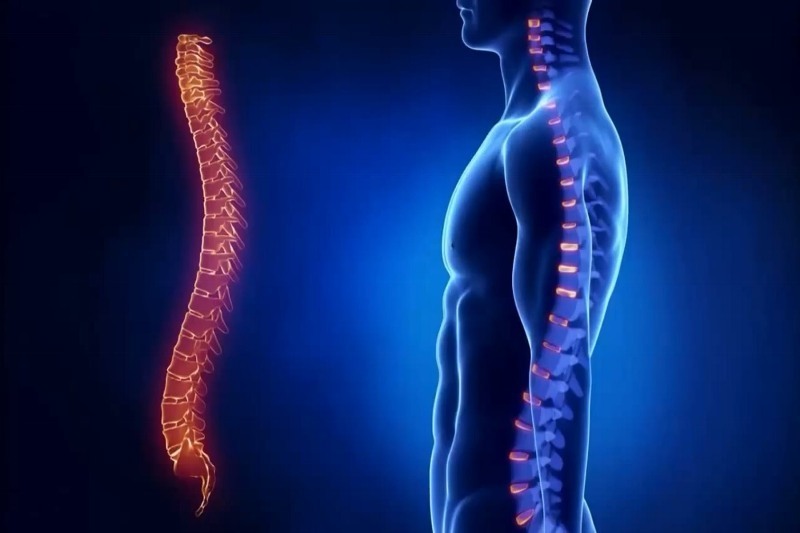 Will they join the army with spondyloarthrosis?
Will they join the army with spondyloarthrosis? Patients with this pathology are registered with disability. Therefore, the question: will they be taken into the army with spondyloarthrosis, you can answer unequivocally-no. Such a diagnosis is the basis for liberation from the army.
Does spondiloarthrosis cause sickness, disability?
 Does spondiloarthrosis cause sickness, disability?
Does spondiloarthrosis cause sickness, disability? As mentioned above, with spondylarthrosis, a disability group is assigned, which depends on the clinical picture of pathology, inflammatory processes, and joint function. Disability can be appointed after the survey. At the first group of disability, labor activity is prohibited.
The hospital list for spondyloarthritis disease is given if the person has impaired motor activity due to pain and inflammation. In this case, the doctor prescribes treatment with medicaments in the form of blockade or tablets. When the pain subsides, a person returns to work.
Spondyloarthrosis: what sanatoriums are treated?
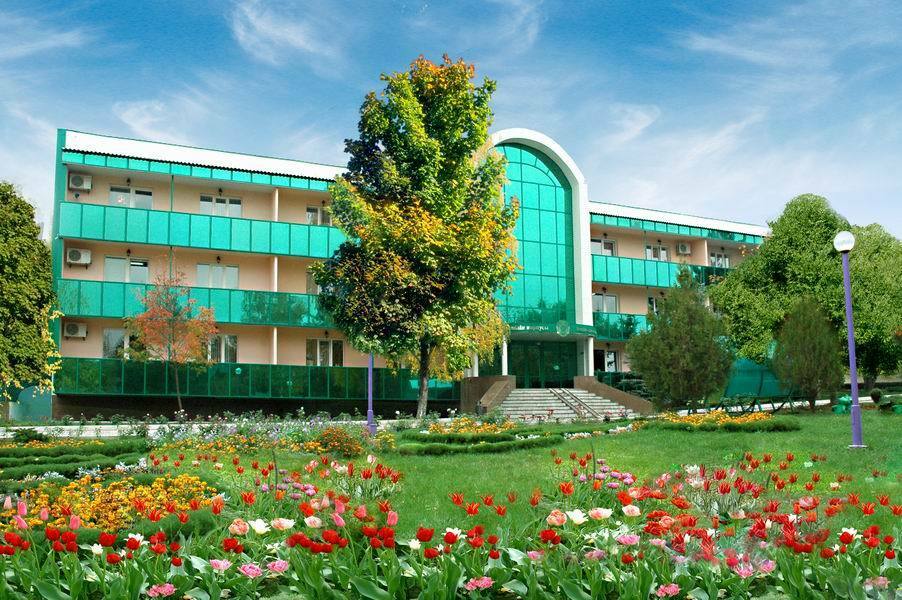 Spondyloarthrosis: what kind of sanatoriums are treated?
Spondyloarthrosis: what kind of sanatoriums are treated? Sanatoriums offer a set of measures aimed at preventing the development of the disease and improving the quality of life of the patient. Procedures are performed using heat and cold, ultrasound sessions are performed. Therapeutic exercise will help strengthen the back muscles, improve metabolism and develop joints.
Which sanatoriums treat spondylarthrosis? Here are some medical institutions:
- "Staraya Russa" - Novgorod region.
- "Naftalan" is the city of Ganja in Azerbaijan.
- "Hot Key" - Krasnodar Territory.
It should be noted that spondyloarthrosis can be treated in any sanatorium, whose profile is aimed at treating diseases of the musculoskeletal system. There are such sanatoriums in almost every city in Russia:
- Bakirovo;
- Yeisk;
- Nalchik;
- Pyatigorsk;
- Ust-Kachka;
- of Кemeri;
- Keys;
- Krasnousolsk;
- Nemyriv.
 Spondyloarthrosis: which sanatoriums treat this disease?
Spondyloarthrosis: which sanatoriums treat this disease? Also in the treatment of spondyloarthrosis is sanatorium Sergievskie Mineral Waters in the Samara region and health resort Chapaeva in Ershov district of the Saratov region.
Timely treatment of a doctor is the key to a successful fight against ailment. Do not self-medicate!
